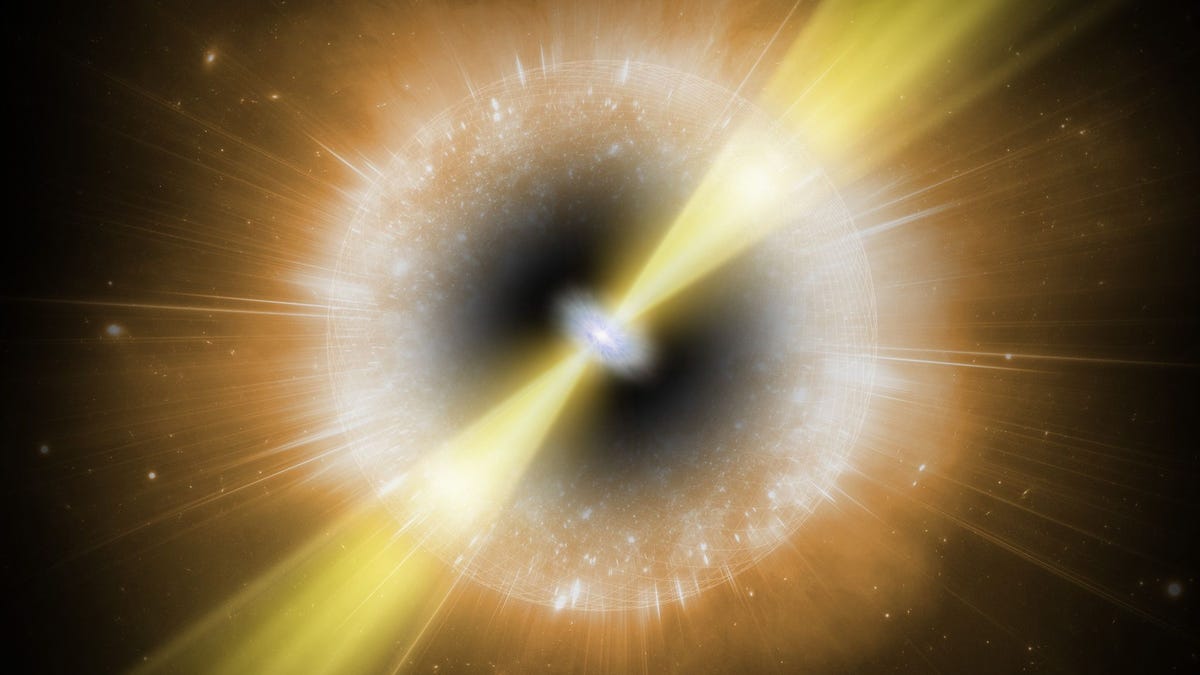Astronomers may have solved the mystery of the brilliant blue cosmic 'cow'
The flash of light from deep space has puzzled astronomers since its discovery in 2018.

An artist's impression of mysterious burst AT2018cow
The year is 2018. Worldwide, astronomers are staring at a strange signal on their telescopes -- a dazzling blue flash of light amid the void of space. It looks like a star explosion, but it's inexplicably brighter by several orders of magnitude. It doesn't match any known classes of supernova. Soon, this very glimmer will earn its place on the wall of cosmic mysteries.
It will become known as AT2018cow, or simply, "the cow."
Fast forward to the present. A team of researchers from the Massachusetts Institute of Technology finally pieced together that the cow's puzzle goes far beyond a stellar explosion, or supernova. Some 200 million light-years away, they say, a star collapse gave rise to a monstrous compact object or, in other words, a relatively small body with an immense mass.
The contenders? A vicious black hole that immediately woke up to suck in any and all matter that had the misfortune of treading too close, or a neutron star so dense a single tablespoon of it would equal something like the weight of Mount Everest.
"Usually, I dare not say 'first time,'" said Dheeraj "DJ" Pasham, a research scientist in MIT's Kavli Institute for Astrophysics and Space Research and lead author of a paper on the findings, published Monday in the journal Nature Astronomy.
"But I truly think this is the first time that you have direct confirmation, so to say, that a star dies and you immediately see the baby compact object."
Deducing 'the cow'
Let's first get something out of the way: Why is it called the cow? Well, that's just a silly serendipity stemming from a standard astronomical naming system. The cow is dubbed an "astronomical transient," due to its intense yet fleeting nature. The first astronomical transient was dubbed "aaa," and the letter system somehow fell on "cow" at the very moment this strange glint entered our repertoire of galactic oddities.
Happy accidents aside, the key to finding the cow's source lay in the glimmer itself. "It had X-rays," Pasham said, "which is extremely unusual for supernovae to have." Upon closely scrutinizing heaps of data collected by NASA's Neutron Star Interior Composition Explorer, Pasham and fellow researchers saw that those X-rays behaved in a way characteristic of compact objects.
An image of the cow in a distant spiral galaxy.
The deductive method went something like this:
The team found each X-ray burst occurred at a frequency of 225 hertz, or once every 4.4 milliseconds over a span of 60 days. "That's really fast," Pasham said. "Based on this, you could take that timescale and multiply by the speed of light to get the absolute maximum size of a region contained within this zone -- you get the maximum size of an object that is causing these pulses."
That size, he found, must be less than about 1,000 kilometers (just over 621 miles) wide. But remember, a supernova caused whatever is creating those X-ray pulses, meaning the dead star's matter is constrained in the tiny space.
What has lots of matter in a small space? A black hole or neutron star.
A wild claim turns to scientific truth
Since the cow's first sighting, astronomers have proposed various scenarios to explain its existence. One of the more "reasonable" conclusions was that a medium-sized black hole devoured a star. "It was kind of a pleasant surprise," Pasham said of finding the less likely, but more interesting option, to be the answer.
"Claiming that I've identified the presence of the compact object, in my opinion, is an extraordinary claim, so I was a little bit hesitant for a long time," he acknowledged. "For several months, actually, I just kept it to myself because I wasn't sure if something so extraordinary could happen."
But after revisiting the data and covering every track he could, he began to feel like it's time to let the world know about the cow's unique source.
The next step, Pasham says, is to identify whether the newborn object is a black hole or a neutron star. To do so, he would need to pin down the exact period of the neutron star, also referred to as a pulsar. A period is the time it takes for the object to make one revolution cycle. "That would be the smoking gun that 'Yes, it's a pulsar and not a black hole,' Pashem said. "That is actually planned, but it's just computationally extremely expensive."
On the note of complex calculations, Pasham's current project was rather impressive as well. The X-ray photons the team studied, he said, came to about 100,000 in total. While that may seem like a big number to work with, it's not. "To give you an idea," he said, "the bulb that you turn on in your room is giving out something like 10^21 optical photons per second -- here we had a source that is doing two photons [per second]"
He added: "It was really interesting to see that we can learn so much about the cosmos with literally two or three counts per second."

